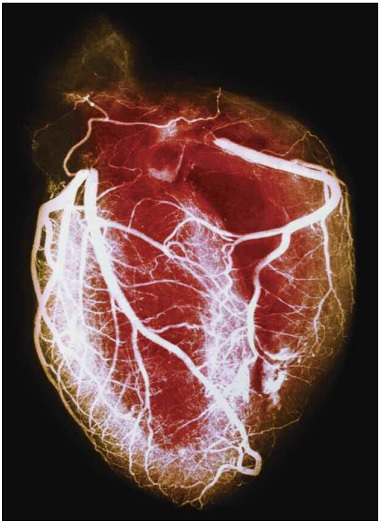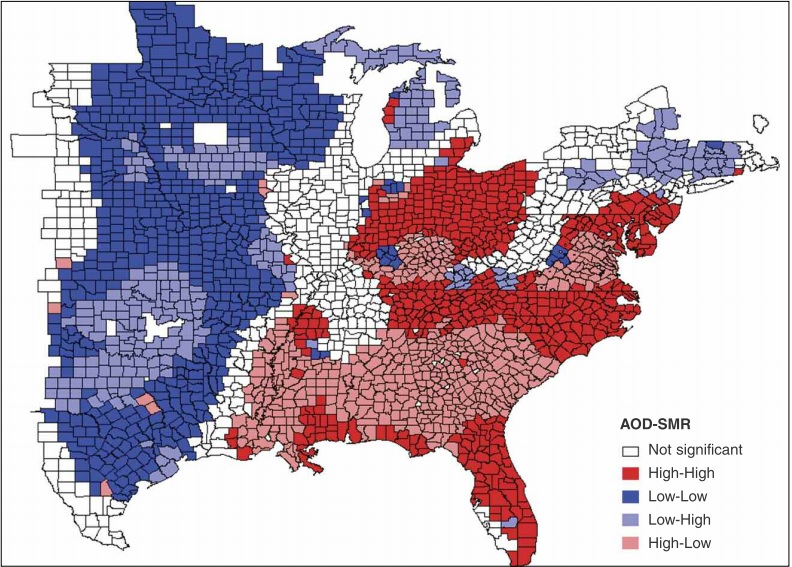On any bright warm day, Americans head out to run, bike, or walk their way to fitness, building stronger hearts and bodies in hopes of a healthier and possibly longer life. But as they breathe in air that may be polluted, do they actually risk damaging their hearts and health? Increasingly, health researchers are finding connections between air pollution and heart disease, and they are getting help from environmental researchers in the form of satellite data on air pollution.
From lungs to heart
John Lanza is an epidemiologist and director of the Escambia County Health Department in Pensacola, Florida. His agency and others like it across the United States pay attention to disease and environmental connections, as they work to improve and safeguard public health. In his region and across the eastern United States, skies are often white with haze from dense automobile traffic in the cities, and coal-burning power plants spew more particulate matter to the skies. Researchers are still learning all the ways that these particulates may damage health.
Lanza said, “Anytime you burn something, you release particulate matter.” Burning of fossil fuels loads the air with fine particulate matter, defined as particles smaller than 2.5 micrometers (in comparison, a human hair is 40 to 50 micrometers wide), and invisible to the human eye. These very small particles are especially hazardous to health; they are small enough to get deep into the lungs, where they can cause illnesses such as asthma, respiratory infections, and lung cancer.
It seems intuitive that breathing in pollutants could damage lung tissue, and in fact, research has strongly connected fine particulate pollution to respiratory disease. A less intuitive effect now drawing attention is the possible link between particulates and the heart. While medical studies have yet to conclusively prove this link, the evidence is mounting.
In 2004, a report by the American Heart Association cited an increasing body of evidence supporting the link between air pollution and heart disease. Studies have shown that fine and ultra-fine particulate pollution can pass through the lungs and enter the bloodstream, which carries the pollutants to other organs, inflaming heart tissue, triggering heart arrhythmias, and provoking plaque in the arteries to rupture and cause a clot. These are only a few of the ways that researchers think that particulate pollution accelerates heart disease or causes early death.
But while medical science has established the mechanisms that cause inhaled pollution to trigger illness in the human body, proof of the link between pollution and heart disease remains elusive. “Researchers have been trying to connect heart disease and pollution for a long time,” Lanza said. The causes of heart disease are complex, and teasing out the effects of pollution from other causes, such as heredity, smoking, and diet, has been challenging to prove in carefully controlled prospective studies, which follow human subjects over long periods. These studies are expensive, and take decades to provide results. In the shorter term, more data and evidence will help add to the reasons to reduce particulate pollution in the interest of public health. “The more information we have, the more we can do,” Lanza said.
Environment and health
Geographer Zhiyong Hu at the University of West Florida in Pensacola thinks environmental satellite data could be helpful in advancing knowledge about particulate pollution and heart disease. He first became interested in air quality measurements for health studies when he participated in an earlier, broader health study, using ground monitoring equipment and air quality models.
But ground measurement stations are sparse, especially in rural areas and developing countries. Hu was familiar with air quality research using satellite data, which provides wider and more uniform spatial and temporal coverage. Hu said, “There have been a few projects using similar methods; normally they try to link satellite and ground measurements.” Interest in such studies is growing, as research demonstrates how satellite data can detect pollution levels relevant to health; NASA researchers are currently working to integrate data on particulates and other environmental factors into a U.S. Center for Disease Control database of public health records.
Hu’s study focused on data from NASA's Moderate Resolution Imaging Spectroradiometer (MODIS) sensors. Flying on both the Aqua and Terra satellites, MODIS views the entire surface of the Earth every one to two days. Its spectral channels were designed to observe many features of land, oceans, and atmosphere, but it turns out that MODIS is also good at picking up aerosols for monitoring surface air quality. An algorithm retrieves aerosol optical depth (AOD), which researchers can use to estimate particulate matter concentrations.
The task was to put together a model that combines the air quality data with health data, as well as an algorithm to flag trouble spots. If it is true that air pollution plays a role in heart disease, Hu expected that areas with high AOD measurements would also show higher mortality rates than areas with low AOD.
Satellite pixels and disease polygons
Aligning two completely different types of data can be like comparing apples and oranges, so Hu and colleague Ranga Rao, who is skilled in working with health statistics, figured out how to standardize and geographically align MODIS data on air quality to heart disease mortality statistics. This work allowed the researchers to compare the data, and found that the correlation in the eastern United States was significant: areas with high mortality rates corresponded with high AOD concentrations during the one-year study period, from 2003 to 2004.
Besides its spatial and temporal coverage, Hu sees several advantages to satellite remote sensing data. It presents the possibility that satellite air quality data can point at health trouble spots. “Remote sensing can fill data gaps, where health data and other pollution monitoring are not available,” he said. The environmental data also add to the increasing evidence of a pollution-heart disease connection that can stimulate further biological studies. And aggregated data on disease is in many ways more similar to a satellite pixel than to point data from a ground instrument.
Hu’s work does not prove that air pollution causes heart disease. He said, “My research is indicative, not causative. I am a geographer, not a biomedical scientist; we do research from different perspectives. Mine is ecological, geographic, from space.” He hopes that his research stimulates more inquiry into both health and into satellite monitoring of air quality. “This kind of research could help governments around the world make policies to target polluted areas in the interest of public health,” he said.
With increasing evidence that links air pollution to heart disease, public health agencies are working to educate people in ways that will protect public health. Lanza said, “We put out public information on ways to reduce particulate matter in the air. We’ve helped get anti-idling laws for commercial trucks, and promoted the benefits of electric lawnmowers and leaf blowers, for example.” Research on pollution and health also provides compelling evidence for bigger efforts to reduce pollution. Lanza said, “We worked with the local coal plant, which was grandfathered in and did not have to comply with EPA [Environmental Protection Agency] standards. They have decided to spend almost a billion dollars installing scrubbers to reduce their emissions.” In the near future, Lanza and other health officials will be monitoring the 2010 Gulf oil spill for air quality degradation and long-term health effects. “It’s still too early to know,” Lanza said.
Of Hu’s study, Lanza said, “It is one way of looking at a disease causation that will be useful because it is a lot less expensive than prospective studies. It’s a fifty thousand foot view.”
References
Brook, R.D. et al. 2004. Air pollution and cardiovascular disease: A statement for healthcare professionals from the expert panel on population and prevention science of the American Heart Association. Circulation 109: 2,655-2,671, doi:10.1161/01.CIR.0000128587.20041.C8.
Environmental Protection Agency. Basic information: Particulate matter. https://www.epa.gov/pm-pollution.
Hu, Z. and K.R. Rao. 2009. Particulate air pollution and chronic ischemic heart disease in the eastern United States: a county level ecological study using satellite aerosol data. Environmental Health 8:26, doi:10.1186/1476-069X-8-26.
For more information
NASA Level 1 and Atmosphere Archive and Distribution System Distributed Active Archive Center (LAADS DAAC)
Moderate Resolution Imaging Spectroradiometer (MODIS)
| About the remote sensing data | ||
|---|---|---|
| Satellites | Terra and Aqua | |
| Sensor | Moderate Resolution Imaging Spectroradiometer (MODIS) | |
| Data set | MODIS Level 2 Aerosol | |
| Resolution | 10 kilometer | |
| Parameter | Aerosol optical depth | |
| DAAC | NASA Level 1 and Atmosphere Archive and Distribution System Distributed Active Archive Center (LAADS DAAC) | |


